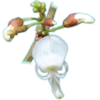Solori scandens
Lianas, basal diameter 2–5 cm. Twigs 3–5 mm diam., thinly strigose to glabrous, lenticels throughout. Stipules triangular, 1–1.5 by 0.9–1.3 mm, outside sericeous, inside glabrous. Leaves with 9–13 leaflets; petiole 2–5 cm long, grooved above, thinly hirsute or sometimes glabrescent; rachis 5.5–10 cm long, grooved above, (thinly) hirsute to glabrous; pulvinus 3–7 mm long. Stipellae present or sometimes inconspicuous, acicular, up to 1.5 mm long. Leaflets subcoriaceous; terminal one elliptic to obovate, 4.5–8 by 1.5–3.2 cm, length/width ratio 2.5–3, base cuneate to broadly cuneate or rounded, apex obtuse, usually emarginate or shortly obtusely acuminate, acumen 2–6 mm long, emarginate to rarely rounded, upper surface shiny, glabrous to slightly strigose along midrib, lower surface thinly strigose, midrib and veins slightly raised or flat above, raised below, veins 7–12 per side, 3–5 mm apart, curving towards the apex and sometimes reaching the margin, sometimes anastomosing near the margin, venation reticulate; lateral ones mostly like terminal, elliptic to ovate, rarely obovate, 3–6.8 by 1.2–3.5 cm, length/width ratio 1.9–2.5; pulvinus 1.5–5 mm long. Inflorescences axillary pseudoracemes, rarely several together as pseudopanicles, 5–28 cm long, peduncle 1.5–5 cm long, thinly strigose. Bracts subtending brachyblasts ovate-triangular, 0.7–1 by 0.5– 0.7 mm, outside sericeous, inside glabrous; bracts subtending flowers elliptic to ovate, 0.6–0.7 by 0.3–0.5 mm, outside sericeous, inside glabrous. Pedicels 5.5–9 mm long, sericeous. Brachyblasts knob-like, 2–6 mm long, 5–10-flowered, sericeous. Bracteoles at the base of the calyx, elliptic or ovate, 0.5–0.8 by 0.3–0.7 mm, outside pubescent, inside glabrous. Calyx reddish or greenish-red, 2.5–2.7 mm high, outside sericeous, inside glabrous, tube ca. 2 mm high; upper lip and lateral lobes hardly visible; lower lobe triangular, ca. 0.7 by 1.5–2 mm. Corolla white to pale pink. Standard: claw 2–3 mm long; blade orbicular or obovate, 5–8 by 6–8 mm, apex emarginate, without auricle or basal callosities, outside glabrous or sometimes slightly sericeous at apex, ciliate in lower part to up to halfway, inside glabrous. Wings: claw 2–2.5 mm long; blade narrowly obovate, 4.5–6.5 by 1–1.5 mm, apex rounded, outside slightly sericeous at the apex and distinctly strigose on both auricles, inside glabrous, upper auricle ca. 0.5 mm long, lower auricle hardly visible, lateral pocket inconspicuous. Keel petals: claw 2.3–2.5 mm long; blade boat-shaped, 6–6.5 by 2.3–2.5 mm, apex rounded, outside hairy at the apex, sometimes also along the major veins ventrally, inside glabrous, auricle and lateral pocket hardly visible. Stamens monadelphous, with basal fenestrae, white, 9–12 mm long, free part of filaments 1.5–3.5 mm long, glabrous; anthers 0.3–0.5 by 0.3–0.4 mm, glabrous. Disc short-tubular, more or less distinctly (5–)10-lobed, up to 0.6 mm high. Ovary hairy, 4–5 mm long, stipe hairy, ca. 1 mm long; ovules 8–10; style 4–5.5 mm long, glabrous but slightly hairy at base. Pods strap-like, 4.5–9 by 0.7–1.5 cm, flat, bulging around the seeds, with a wing along the upper suture only, wing 1–2 mm wide, thinly sericeous; seed chamber hard, usually visible from outside. Seeds bean-shaped, flat, ca. 7 by 5 by 1 mm; hilum central, ca. 1 mm long.
A widespread species ranging from Reunion island to India, Sri Lanka, Bangladesh, Myanmar, throughout Indochina, Thailand, Malay Peninsula, Sumatra, Borneo, Java, Philippines, Celebes, Lesser Sunda Islands, Papua New Guinea (Morobe Prov.), and Australia.
Occur in various types of vegetation: open and disturbed or abandoned cultivated areas, shrubbery, agricultural areas, edges of rice fields, grasslands, or beach or mangrove forest, up to 750 m
Flowering from July to September, or throughout the year; fruiting from December to August.
